What is photo watermarking?
Watermarking is the process of superimposing a transparent message (usually a signature, stamp, or logo) onto a picture or photograph. You’ve seen this if you’ve ever tried to purchase a shot from a stock photo website.
Here’s an example of a photograph with a watermark from Theo Crazzolara

There’s an active discussion in the photography community on whether watermarking is a good practice or not. You’ll find professionals on both sides, just like the endless Nikon versus Canon debate.
The purist thinks that watermarking can detract from composition. On the other hand, plenty of photographers love the branding opportunity and copyright protection that watermarks provide.
Here are three reasons not watermarking is costing you reputation, rights, and revenue.
Reputation: Branding Your Business
Bob, the Photo Purist, will blabber about bokeh, deadpan, and forced perspective as he lectures on how only amateurs use watermarks.
But Bob has a secret addiction.
His favorite brand has him ‘liking’ every ad, commercial, and product. He’ll be sleeping on store sidewalks before a release date. All this despite their logo of a half-bitten piece of fruit being plastered all over everything (apparently Bob doesn’t think all logos are tasteless). Okay, you figured it out. It’s Apple, and yes, they can do that.
But you can brand like Apple too. What can you learn from Apple’s brand strategy? Put your logo on a high-quality product (that’s what your photos are), and people will associate the stories your products tell, with you.
Bob drones on. “Your shot will never go viral with that watermark.” Ahem, what good is attention if no one knows your name? And your watermark will be simple, inconspicuous, and above all, classy. Give people every opportunity to find your business. This is even more critical if you are just starting out.
Rights: Protecting Your Work with Photo Watermarking
Your watermark won’t stop a dedicated and premeditated photo thief. He’ll use a specialist tool to remove your watermark. But you cannot not stop this thief either way (or get a cent from him if you could even track him down). So why watermark?
If you ever catch up with that thief, you can prove that he deliberately intended to steal your photo. A legitimate business will contact and pay to use your work. For photographers who pass your photos off as their own, you can go after them with legal guns blazing.
Normal internet users don’t understand they’re stealing your work when they “Right click->Save” your photo. Your watermark will deter folks looking to add flair to a dry memo or blog post. Because removing a watermark is work and let’s face it, people are lazy. If someone does snag your stuff, going back to our first point, they’ve given you free advertising.
Revenue: The Print Income Stream
Many photographers are losing a revenue stream by focusing on digital only and missing print. Canvases, albums, and even large-scale prints are all ways to monetize your craft.
Watermarking preview-copies prevents your customers from downloading and printing the low-resolution photos. Allowing your clients to print low-resolution photos does them a disservice, and makes your work look amateur and shoddy.
Customers should pay you to print photos or get a high-res image so you can add value with your unique sense of aesthetic appeal. Watermark your photos and make your clients opt for higher quality.
Photo Watermarking Made Easy
One secret of work and life is that “you should do you.” Treat your business like a business, even if it is only a part-time hobby. If you’re want to put a watermark on your photos quickly and easily, then try SnapSentry to watermark your photos for free. Quickly watermark a whole album of photos in a few clicks.
Remember, aim to make your watermark classy like a high brow wedding photographer, obvious enough to get the job done but unobtrusive enough to never ruin the shot or moment.
Back to Blog
